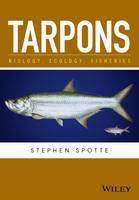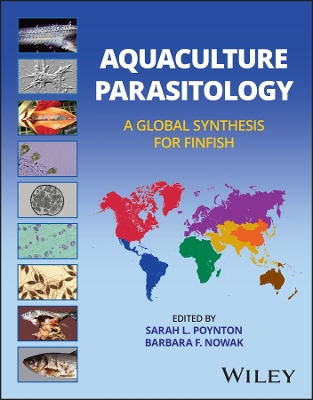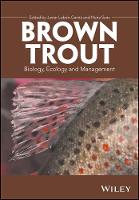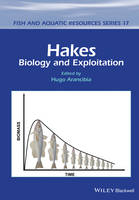Tarpons
 -15%
portes grátis
-15%
portes grátis
Tarpons
Biology, Ecology, Fisheries
Spotte, Stephen
John Wiley & Sons Inc
07/2016
344
Dura
Inglês
9781119185499
15 a 20 dias
814
Descrição não disponível.
Preface vii
Acknowledgements xi
Symbols and abbreviations xii
1 Development 1
1.1 Introduction 1
1.2 The tarpon leptocephalus 1
1.3 Staging tarpon ontogeny 4
1.4 Development of Atlantic tarpons 10
1.5 Development of Pacific tarpons 24
1.6 Leptocephalus physiology 33
2 Growth 39
2.1 Introduction 39
2.2 The cube law 40
2.3 Sexually dimorphic growth 41
2.4 Condition 44
2.5 Growth rate 49
2.6 Modeling growth 52
2.7 Tarpon larvae 58
3 Spawning 59
3.1 Introduction 59
3.2 Fecundity and early survival 59
3.3 Where tarpons spawn 64
3.4 When tarpons spawn 68
3.5 Size and age at maturity - Atlantic tarpons 72
3.6 Size and age at maturity - Pacific tarpons 78
4 Recruitment 80
4.1 Introduction 80
4.2 Life in the plankton 80
4.3 Inshore migration 83
4.4 Offshore migration 85
4.5 Mechanisms of recruitment 88
4.6 Factors affecting recruitment 89
5 Breathing and respiration 96
5.1 Introduction 96
5.2 Water?-breathing 97
5.3 Air?-breathing 100
5.4 Cardiovascular function 108
5.5 Hypoxia 113
5.6 Hypercapnia 125
5.7 Air?-breathing as social behavior 126
6 Osmo?- and ionoregulation 128
6.1 Introduction 128
6.2 Osmo- and ionoregulation 130
6.3 Ionocytes 132
6.4 Acid?-base regulation 136
6.5 Ammonia excretion 137
6.6 Euryhaline transition 141
6.7 Endocrine factors 144
6.8 Eggs and larvae 147
7 Ecology 152
7.1 Introduction 152
7.2 Habitats 152
7.3 Predators of tarpons 159
7.4 Environmental factors affecting survival 162
7.5 Gregariousness 166
7.6 Seasonal movements 167
7.7 Feeding and foods 174
8 Fisheries 186
8.1 Introduction 186
8.2 Recreational fisheries 186
8.3 Handling 190
8.4 Stress effects 195
8.5 Commercial fisheries 211
8.6 Aquaculture 215
8.7 Populations 219
8.8 Final note: whom should we save? 224
Appendices 232
References 286
Index 323
Acknowledgements xi
Symbols and abbreviations xii
1 Development 1
1.1 Introduction 1
1.2 The tarpon leptocephalus 1
1.3 Staging tarpon ontogeny 4
1.4 Development of Atlantic tarpons 10
1.5 Development of Pacific tarpons 24
1.6 Leptocephalus physiology 33
2 Growth 39
2.1 Introduction 39
2.2 The cube law 40
2.3 Sexually dimorphic growth 41
2.4 Condition 44
2.5 Growth rate 49
2.6 Modeling growth 52
2.7 Tarpon larvae 58
3 Spawning 59
3.1 Introduction 59
3.2 Fecundity and early survival 59
3.3 Where tarpons spawn 64
3.4 When tarpons spawn 68
3.5 Size and age at maturity - Atlantic tarpons 72
3.6 Size and age at maturity - Pacific tarpons 78
4 Recruitment 80
4.1 Introduction 80
4.2 Life in the plankton 80
4.3 Inshore migration 83
4.4 Offshore migration 85
4.5 Mechanisms of recruitment 88
4.6 Factors affecting recruitment 89
5 Breathing and respiration 96
5.1 Introduction 96
5.2 Water?-breathing 97
5.3 Air?-breathing 100
5.4 Cardiovascular function 108
5.5 Hypoxia 113
5.6 Hypercapnia 125
5.7 Air?-breathing as social behavior 126
6 Osmo?- and ionoregulation 128
6.1 Introduction 128
6.2 Osmo- and ionoregulation 130
6.3 Ionocytes 132
6.4 Acid?-base regulation 136
6.5 Ammonia excretion 137
6.6 Euryhaline transition 141
6.7 Endocrine factors 144
6.8 Eggs and larvae 147
7 Ecology 152
7.1 Introduction 152
7.2 Habitats 152
7.3 Predators of tarpons 159
7.4 Environmental factors affecting survival 162
7.5 Gregariousness 166
7.6 Seasonal movements 167
7.7 Feeding and foods 174
8 Fisheries 186
8.1 Introduction 186
8.2 Recreational fisheries 186
8.3 Handling 190
8.4 Stress effects 195
8.5 Commercial fisheries 211
8.6 Aquaculture 215
8.7 Populations 219
8.8 Final note: whom should we save? 224
Appendices 232
References 286
Index 323
Este título pertence ao(s) assunto(s) indicados(s). Para ver outros títulos clique no assunto desejado.
Tarpon; Atlantic tarpon; Pacific tarpon; Megalops atlanticus; Megalops cyprinoides; Tarpon biology; Tarpon ecology; Tarpons fisheries; Tarpon conservation
Preface vii
Acknowledgements xi
Symbols and abbreviations xii
1 Development 1
1.1 Introduction 1
1.2 The tarpon leptocephalus 1
1.3 Staging tarpon ontogeny 4
1.4 Development of Atlantic tarpons 10
1.5 Development of Pacific tarpons 24
1.6 Leptocephalus physiology 33
2 Growth 39
2.1 Introduction 39
2.2 The cube law 40
2.3 Sexually dimorphic growth 41
2.4 Condition 44
2.5 Growth rate 49
2.6 Modeling growth 52
2.7 Tarpon larvae 58
3 Spawning 59
3.1 Introduction 59
3.2 Fecundity and early survival 59
3.3 Where tarpons spawn 64
3.4 When tarpons spawn 68
3.5 Size and age at maturity - Atlantic tarpons 72
3.6 Size and age at maturity - Pacific tarpons 78
4 Recruitment 80
4.1 Introduction 80
4.2 Life in the plankton 80
4.3 Inshore migration 83
4.4 Offshore migration 85
4.5 Mechanisms of recruitment 88
4.6 Factors affecting recruitment 89
5 Breathing and respiration 96
5.1 Introduction 96
5.2 Water?-breathing 97
5.3 Air?-breathing 100
5.4 Cardiovascular function 108
5.5 Hypoxia 113
5.6 Hypercapnia 125
5.7 Air?-breathing as social behavior 126
6 Osmo?- and ionoregulation 128
6.1 Introduction 128
6.2 Osmo- and ionoregulation 130
6.3 Ionocytes 132
6.4 Acid?-base regulation 136
6.5 Ammonia excretion 137
6.6 Euryhaline transition 141
6.7 Endocrine factors 144
6.8 Eggs and larvae 147
7 Ecology 152
7.1 Introduction 152
7.2 Habitats 152
7.3 Predators of tarpons 159
7.4 Environmental factors affecting survival 162
7.5 Gregariousness 166
7.6 Seasonal movements 167
7.7 Feeding and foods 174
8 Fisheries 186
8.1 Introduction 186
8.2 Recreational fisheries 186
8.3 Handling 190
8.4 Stress effects 195
8.5 Commercial fisheries 211
8.6 Aquaculture 215
8.7 Populations 219
8.8 Final note: whom should we save? 224
Appendices 232
References 286
Index 323
Acknowledgements xi
Symbols and abbreviations xii
1 Development 1
1.1 Introduction 1
1.2 The tarpon leptocephalus 1
1.3 Staging tarpon ontogeny 4
1.4 Development of Atlantic tarpons 10
1.5 Development of Pacific tarpons 24
1.6 Leptocephalus physiology 33
2 Growth 39
2.1 Introduction 39
2.2 The cube law 40
2.3 Sexually dimorphic growth 41
2.4 Condition 44
2.5 Growth rate 49
2.6 Modeling growth 52
2.7 Tarpon larvae 58
3 Spawning 59
3.1 Introduction 59
3.2 Fecundity and early survival 59
3.3 Where tarpons spawn 64
3.4 When tarpons spawn 68
3.5 Size and age at maturity - Atlantic tarpons 72
3.6 Size and age at maturity - Pacific tarpons 78
4 Recruitment 80
4.1 Introduction 80
4.2 Life in the plankton 80
4.3 Inshore migration 83
4.4 Offshore migration 85
4.5 Mechanisms of recruitment 88
4.6 Factors affecting recruitment 89
5 Breathing and respiration 96
5.1 Introduction 96
5.2 Water?-breathing 97
5.3 Air?-breathing 100
5.4 Cardiovascular function 108
5.5 Hypoxia 113
5.6 Hypercapnia 125
5.7 Air?-breathing as social behavior 126
6 Osmo?- and ionoregulation 128
6.1 Introduction 128
6.2 Osmo- and ionoregulation 130
6.3 Ionocytes 132
6.4 Acid?-base regulation 136
6.5 Ammonia excretion 137
6.6 Euryhaline transition 141
6.7 Endocrine factors 144
6.8 Eggs and larvae 147
7 Ecology 152
7.1 Introduction 152
7.2 Habitats 152
7.3 Predators of tarpons 159
7.4 Environmental factors affecting survival 162
7.5 Gregariousness 166
7.6 Seasonal movements 167
7.7 Feeding and foods 174
8 Fisheries 186
8.1 Introduction 186
8.2 Recreational fisheries 186
8.3 Handling 190
8.4 Stress effects 195
8.5 Commercial fisheries 211
8.6 Aquaculture 215
8.7 Populations 219
8.8 Final note: whom should we save? 224
Appendices 232
References 286
Index 323
Este título pertence ao(s) assunto(s) indicados(s). Para ver outros títulos clique no assunto desejado.






